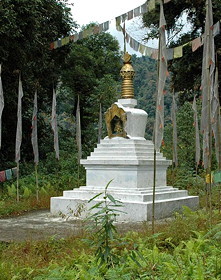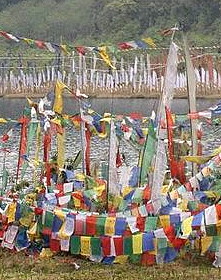
Lake Khachoepalri
(Chu-Shug-Tso)
The Sikkimese Bhutia-Lepchas, along with some of the other communities who practice Buddhism in Sikkim , are guided by the Patron Saint of Sikkim, Guru Padmasambhava, who is a historic personality, not a mythological one. He visited Sikkim sometime in the early eighth century and declared this land as Bayul Demojong, the land of Sacred Treasures, replete with fruits, flowers and medicinal plants, as also hidden sacred texts. The Guru conceived Khachoepalri Lake in his meditation. The lake was somehow desecrated in 1780. Later, a monk went one day to the desecrated lake, and was praying when the deity of the lake surfaced and pleaded with the monk to take her to a sacred place. The monk then found in his meditation the Khachoepalri area in the west district of Sikkim, as described by Guru Padmasambhava.
Khachoepalri is a holy mountain, atop which stands a famous and profound Monastery including the unparallel Balyul Chorten (the replica of the sacred Boudha Stupa of Kathmandu). The monk took the direction from his meditation and reached the mountain and rested at the Monastery. That evening in his meditation, he was directed to a hollow space at the base of the mountain, where he took water he had brought from the earlier lake. There, he prayed and pleaded the deity "Oh Lady, please sit here" and poured the water into the land, "Oh Lady please sit here" is "Chu-Shug-Tso" in Sikkimese language, and though the lake is now referred to as Khachoepalri, its original name is "Chu-Shug-Tso". In its rather more sacred rendering, it is known as the Pemachen gyi Tso.
The Khachoepalri Lake is central to the faith practiced by Sikkimese Buddhist, and it is also renowned internationally as a wish fulfilling lake. However there are well placed norms about the manner in which the ritual and prayer is to be conducted at the lake. Originally, one had to cross a spring by walking over a strong log. The devotees, including members of the Royal Family, would take ablutions at the stream, and go inside the lake premises. There, they would pray, and if they wanted to take a bit of water from the lake they asked the priests to cut a fresh bamboo, and carve out a cup-like holder. This would be dipped into the water, and the holy water taken out.
Every year, especially at the beginning of the Sikkimese Lunar calendar year, Buddhist prayers (known as Naysol) are conducted at the Khachoepalri Lake. These prayers are meant for conservation of environment and are offered to all the deities of Sikkim along with the deity of the lake (Nay Dolkar Lhamo). The prayers of the Buddhist faith are also meant for universal benevolence and well-being of all sentient beings. The Khachoepalri Monastery at the top of the hill overlooks the lake and is as sacred to the Buddhist community including the Bhutia-Lepchas as the Lake itself. The head monk of the monastery is an incarnate monk.
A norm has to be followed when the devotees visit the lake to pay their obeisance: They are required to wash their hands at a nearby stream before they approach the lake, they have to carry bamboo shoots, which are inserted in the lake to extract the holy water from the lake, which is considered as amrit or nectar and is believed to have special therapeutic value. Never ever has the holy water from the lake been touched by any person, and nobody's part is allowed to be touched with the lake water. Taking a dip in the holy water of the lake is strictly prohibited and is against the basic tenets of the religious practice attached with Khachoepalri Lake.
The Government of Sikkim, vide its Notification (No. 59/HOME/98) dated 26.10.1998, issued directions that no conversion or alternation or any new construction or any developmental activity shall be undertaken at the site or in close vicinity of any place of worship or religious institutions in the nature of restoration or construction. The same shall be undertaken only with the prior clearance of the State Government in the Ecclesiastical Department, which is the nodal department to deal with all such matters. The State Government issued another Notification (70/HOME/2001) dated 20.09.2001, on the recommendations of a committee set up for this purpose, declaring 53 sacred peaks, caves, rocks, lakes, Chhoedtens and hot-springs as most sacred Buddhist places of worship in Sikkim and granted them protection under the provisions of the Places of Worship (Special Provisions) Act, 1991. Amongst the said places of worship, Mt. KhangchendDzonga and Khachoepalri Lake were also listed. Vide this Notification, the State Government also banned the scaling of the sacred peaks and defilement of sacred caves, sacred rocks, sacred lakes and sacred hot-springs so notified by the government.
Despite, the sacred lake was unfortunately defiled by Nepal Baba, a Nepali national in 2004, coupled with the ignoring and neglecting attitude of the State Government. This compelled the Sikkimese Bhutia Lepchas to approach the Honorable Supreme Court seeking justice vide case No. W.P. (C) No. 477 of 2004 (Acharya Tshering Lama and others vs. State of Sikkim and others). This unfortunate incidence even transpired the Indian Home Minister Shivraj Patil to instruct the State Government to review the quality and manner of implementation of the Act (The Places of Worship (Special Provision) Act, 1991) vide D.O. No. 13011/3/2004-NI.III dated 09.09.2004. Ultimately, the year 2007 saw the victory of the Sikkimese Bhutia Lepcha people in the said Supreme Court case which infact is the victory of Truth, Dharma and Sangha in Sikkim.
But despite, unseen threats on our dharma and culture go on ...

Sacred waters of lake Khachoepalri

Chorten close to lake Khachoepalri

Prayer flags at lake Khachoepalri